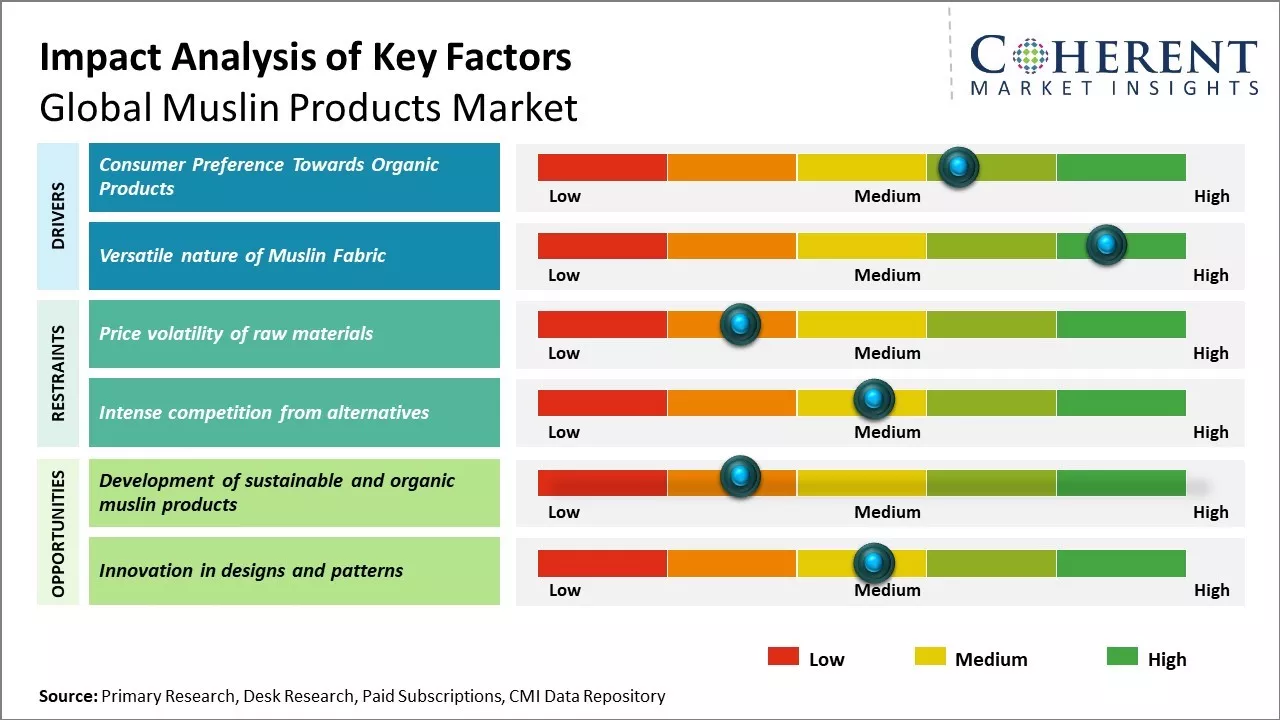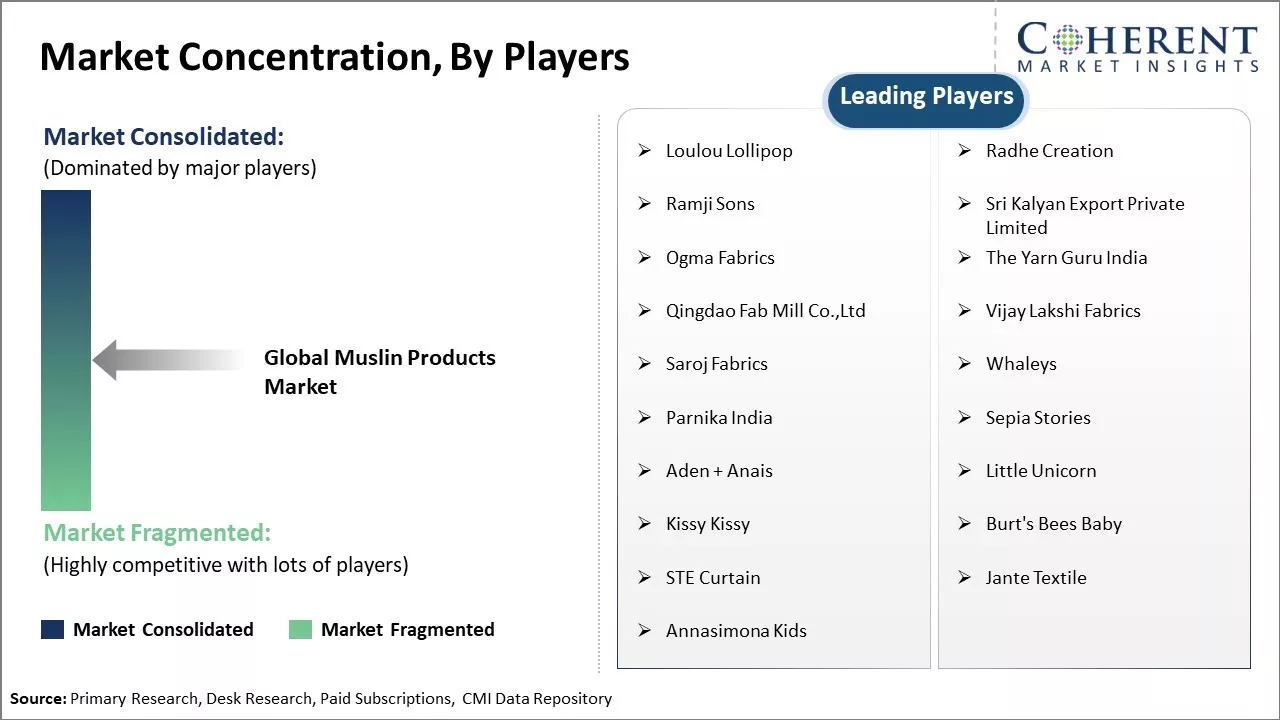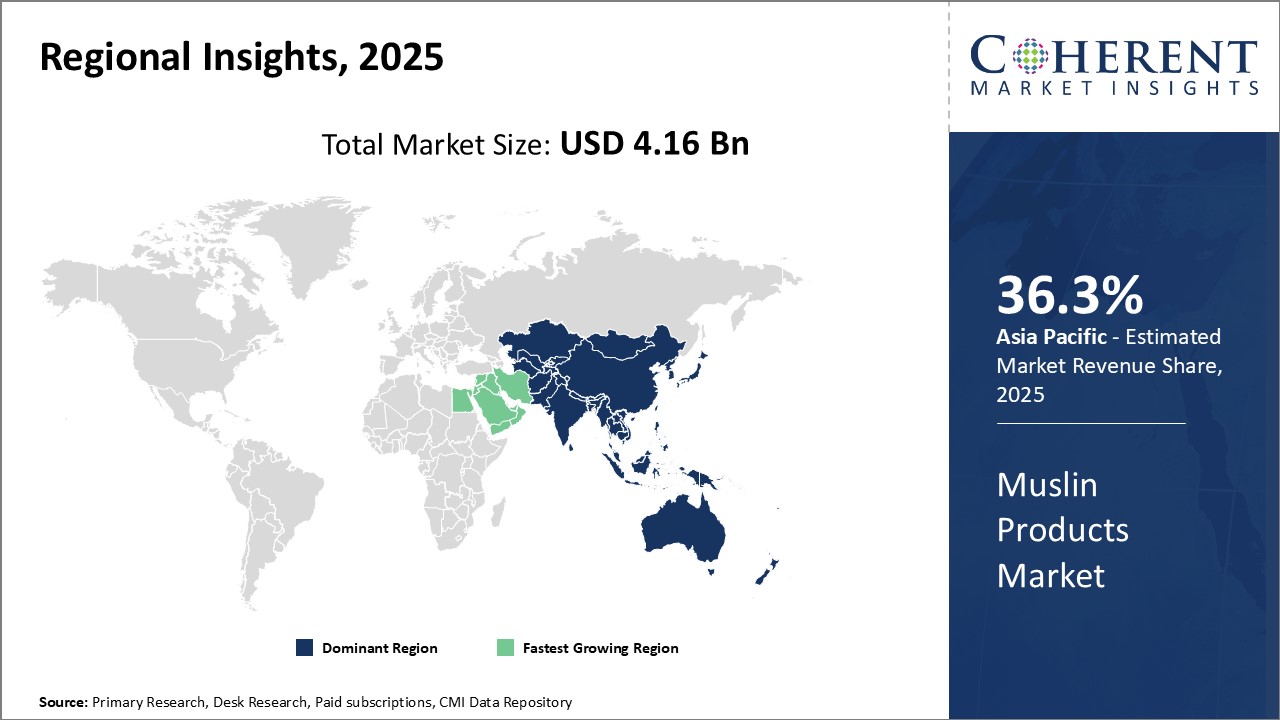Muslin Products Market Size and Trends
The Muslin Products Market is estimated to be valued at USD 4.16 Bn in 2025 and is expected to reach USD 6.25 Bn by 2032, exhibiting a compound annual growth rate (CAGR) of 6.0% from 2025 to 2032.

Discover market dynamics shaping the industry: Download Free Sample
Major players are launching new products to cater to the rapidly growing demand from consumers. Players operating in the market are investing in research & development to come up with new and innovative products to strengthen their market position. Several initiatives by OIC to promote halal products internationally will also contribute to the growth of the Muslin products market during 2025-2032.
Consumer Preference Towards Organic Products
With rising health consciousness amongst consumers across the globe, there is a strong preference for organic and eco-friendly products. Muslin products such as muslin clothes, towels, and baby products are increasingly finding favor amongst consumers who want chemical-free alternatives. Muslin fabrics are naturally breathable and allow the skin to breathe. They are gentle on sensitive skin and preferred by many for babies. With growing awareness about the harmful effects of using synthetic fabrics and chemicals in daily use items, muslin products appeal to those who want toxin-free options. Furthermore, muslin is affordable and durable. Its soft texture is comfortable against the skin. As consumers spend more on products that align with their values, focus on health and sustainability, the demand for organic muslin products is expected to see steady gains. Many new players have emerged in the market offering innovative designs and varied usage of muslin fabrics to cater to this consumer segment. Established brands are also enhancing their product portfolio with organic muslin offerings. This evolving preference for eco-conscious options is likely to act as a key growth driver for the global muslin products industry.
Market Concentration and Competitive Landscape

Get actionable strategies to beat competition: Download Free Sample
Versatile Nature of Muslin Fabric
Muslin fabric is flexible and versatile in nature which allows it to be utilized in varied applications ranging from apparel to home furnishings. This multi-purpose quality opens up opportunities for continuous product innovation and development. The lightweight breathable nature of muslin makes it suitable for many clothing and clothing accessory items. It is commonly used to manufacture casual summer wears, night suits, undergarments, scarves, etc. The soft texture and absorbency of muslin also finds wide usage in making baby products. Items like muslin swaddles, burp cloths, bibs, wraps are very popular. Furthermore, muslin is also gaining prominence for making table linens, curtains, bed sheets and household decorative wares. The versatility enables constant introduction of new and improved product varieties. This ability to be tailored into versatile designs and fulfill growing needs across apparel and interior/furnishing categories is a key factor supporting the expansion of the muslin products industry. As companies explore innovative ways of leveraging muslin’s flexible qualities, it will continue to open new revenue streams and drive higher demands.
Key Takeaways from Analyst:
The Muslin products market looks promising in the coming years. The halal food industry is expected to drive much of the growth backed by the large and growing Muslin population globally. The fastest expanding region for Muslin products will likely be Southeast Asia due to countries with a high Muslin population such as Indonesia, Malaysia, and Pakistan experiencing economic development.
Regulatory differences between countries and inconsistencies in halal certifications can pose challenges. Standardization of certifications and ensuring product ingredients meet religious guidelines across wide geographical ranges will be crucial for companies operating globally.
Overall, the outsourcing of halal food production and rising disposable incomes in developing Asian and Middle-Eastern countries provide avenues for new product launches and category expansion. Multinational companies focused on the global halal industry will need to adapt marketing strategies to local sensibilities and cultures within the targeted regions to achieve success.
Market Challenges: Price volatility of raw materials
Price volatility of raw materials has become a major challenge for the global muslin products market in recent years. Muslin is primarily made from cotton which is an agricultural commodity and its prices fluctuate frequently depending on various factors like seasonal conditions, supply & demand dynamics in the global market etc. Any instability in cotton prices hampers production planning and margins for muslin manufacturers.
Market Opportunities: Development of sustainable and organic muslin products
The development of sustainable and organic muslin products could open up significant opportunities in the global muslin products market. With increasing awareness and demand for eco-friendly products worldwide, a shift towards more sustainable muslin options seems imminent. Muslin is predominantly produced from non-organic cotton which requires extensive use of chemicals at various stages of farming and production. Moving to organic cultivation methods could help reduce dependence on pesticides and fertilizers, lowering the environmental impact. Many nations are also actively promoting adoption of organic farming to sustain soil health over the long run.
Additionally, the use of sustainable and recycled materials for muslin products like bags and clothing could further boost their environmental and social credentials. Several brands are already exploring the potential of agro-waste fibers and surplus textile scraps for reusable muslin products. Transitioning to organic cotton-blend fabrics and eco-friendly dyes/finishes would make muslin truly sustainable. It could attract younger, environmentally-conscious customers who are willing to pay more for sustainable options.

Discover high revenue pocket segments and roadmap to it: Download Free Sample
Insights, by Product Type : The versatile nature of muslin fabric drive the segment growth
In terms of Product Type, the Muslin Fabric segment is estimated to hold 53.2% share of the market in 2025, owing to its incredibly versatile nature. Muslin can be crafted into a wide variety of items to suit an array of uses. Whether for comfortable everyday clothing, decorative home accents, or medical dressings, muslin delivers excellent functionality across different applications. Its breathable weave allows the fabric to mold to the body in a supple yet simple manner. This inherent versatility is Muslin Fabric's strongest selling point, as it can satisfy needs in fashion, interior design, and even healthcare. The material takes dye beautifully as well, lending itself to diverse prints and styles. Most importantly, muslin's adaptability means it remains a practical and affordable choice for multitudes of consumers. The timeless popularity of this hardworking fabric stems from its ability to transform seamlessly between industries while retaining outstanding value.
Insights by End-use Industry : muslin's supreme comfort
Among the segments, the Apparel segment is estimated to hold 35% share of the market in 2025, due to muslin's supreme comfort. As a natural fiber, muslin garments are lightweight, airy, and exceptionally breathable making them ideal for warm weather wear. They absorb sweat to keep the body cool and regulated. The fabric drapes nicely on the skin without clinging too tightly like synthetics. Muslin also tends to be softer over time compared to other basics as it naturally becomes even more supple with washing. Ultimately, muslin clothing is designed for convenience, whether for lounging at home or wearing during daily activities. Its wearers appreciate how the fabric moves effortlessly with their bodies without causing undue heat or restriction. In an era where wellness and ease take top priority, muslin will remain a top choice within the apparel segment for its unmatched comfortable properties.
Insights by Distribution Channel : Accessibility and convenience
Among distribution channels, the Supermarkets/Hypermarkets segment is estimated to hold 37.1% share in 2025, owing to the accessibility and convenience they provide consumers. As bustling one-stop-shops, supermarkets allow effortless in-person browsing and quick purchasing of essentials like muslin items. They centralize numerous brands and options in easily navigable store aisles, saving customers multiple trips to various specialty outlets. Supermarkets also periodically run deals and promotions that help discount-savvy buyers stock up. As busy modern lifestyles accelerate, the appeal of fast and undemanding shopping grows. The broad product ranges and frequent shopping habits encouraged by supermarkets position them as a prime route to market for muslin products. Their widespread physical presence across neighborhoods multiplies visibility as well. Shoppers consistently appreciate supermarkets' simplified browsing and purchasing process for oft-needed items. This will ensure the channel maintains its dominance within the distribution segment.
Regional Insights

Need a Different Region or Segment? Download Free Sample
Asia Pacific has emerged as the dominant region in the global muslin products market, mainly supported by countries like India, Pakistan, and Bangladesh. The Asia Pacific region accounts for over 36.3% of the market in 2025. led by well-established supply chains and a large domestic market. India contributes to almost 25.5% of global muslin exports owing to presence of major muslin manufacturing clusters in states like Bengal, Bihar and Kashmir which produces high quality muslin fabrics. The strategic geographical location of South Asian countries provides easy access to large markets in Middle East, Africa, and South East Asia boosting international trade.
Middle East & Africa Africa is poised to be the fastest growing regional market for muslin products over the coming years. Countries like Nigeria, Ethiopia, and Kenya are expected to fuel most of the future demand growth in this region. Rising disposable incomes and spending on apparel and home textiles in major African economies is one of the key driver for market expansion. Growing tourism and construction activities are also supporting the uptake of muslin home furnishings. While imports dominate the African market currently due to insufficient domestic manufacturing, countries like Kenya and Uganda are focusing on developing their local muslin industries through government incentives and technology transfers. This is expected to reduce the dependence on imports in future and provide market access to international suppliers from South Asia.
Market Report Scope
Muslin Products Market Report Coverage
| Report Coverage | Details | ||
|---|---|---|---|
| Base Year: | 2024 | Market Size in 2025: | USD 4.16 Bn |
| Historical Data for: | 2020 To 2024 | Forecast Period: | 2025 To 2032 |
| Forecast Period 2025 to 2032 CAGR: | 6.0% | 2032 Value Projection: | USD 6.25 Bn |
| Geographies covered: |
|
||
| Segments covered: |
|
||
| Companies covered: |
Loulou Lollipop, Radhe Creation, Ramji Sons, Sri Kalyan Export Private Limited, Ogma Fabrics, The Yarn Guru India, Qingdao Fab Mill Co.,Ltd, Vijay Lakshi Fabrics, Saroj Fabrics, Whaleys, Parnika India, Sepia Stories, Aden + Anais, Little Unicorn, Kissy Kissy, Burt's Bees Baby, STE Curtain, Jante Textile, and Annasimona Kids |
||
| Growth Drivers: |
|
||
| Restraints & Challenges: |
|
||
Uncover macros and micros vetted on 75+ parameters: Get instant access to report
Market Segmentation
- Product Type Insights (Revenue, USD Bn, 2020 - 2032)
- Muslin Fabric
- Plain Weave Muslin
- Jacquard Muslin
- Embroidered Muslin
- Others (e.g. Printed Muslin, Colored Muslin)
- Muslin Garments
- Shirts/Blouses
- Dresses/Skirts
- Scarves/Shawls
- Others (e.g. Trousers, Pajamas)
- Muslin Home Furnishings
- Curtains/Drapes
- Bedding (Sheets, Pillowcases, Comforters)
- Towels
- Others (e.g. Table Linens, Upholstery)
- Others
- Muslin Fabric
- End-use Industry Insights (Revenue, USD Bn, 2020 - 2032)
- Apparel
- Home Textiles
- Personal Care
- Healthcare
- Industrial
- Others (e.g. Hospitality, Automotive)
- Distribution Channel Insights (Revenue, USD Bn, 2020 - 2032)
- Supermarkets/Hypermarkets
- Specialty Stores
- Online Retail
- Direct Sales
- Regional Insights (Revenue, USD Bn, 2020 - 2032)
- North America
- U.S.
- Canada
- Latin America
- Brazil
- Argentina
- Mexico
- Rest of Latin America
- Europe
- Germany
- U.K.
- Spain
- France
- Italy
- Russia
- Rest of Europe
- Asia Pacific
- China
- India
- Japan
- Australia
- South Korea
- ASEAN
- Rest of Asia Pacific
- Middle East & Africa
- GCC Countries
- Israel
- Rest of Middle East & Africa
- North America
- Key Players Insights
- Loulou Lollipop
- Radhe Creation
- Ramji Sons
- Sri Kalyan Export Private Limited
- Ogma Fabrics
- The Yarn Guru India
- Qingdao Fab Mill Co.,Ltd
- Vijay Lakshi Fabrics
- Saroj Fabrics
- Whaleys
- Parnika India
- Sepia Stories
- Aden + Anais
- Little Unicorn
- Kissy Kissy
- Burt's Bees Baby
- STE Curtain
- Jante Textile
- Annasimona Kids
Share
Share
Missing comfort of reading report in your local language? Find your preferred language :
Transform your Strategy with Exclusive Trending Reports :
Frequently Asked Questions
EXISTING CLIENTELE
Joining thousands of companies around the world committed to making the Excellent Business Solutions.
View All Our Clients
